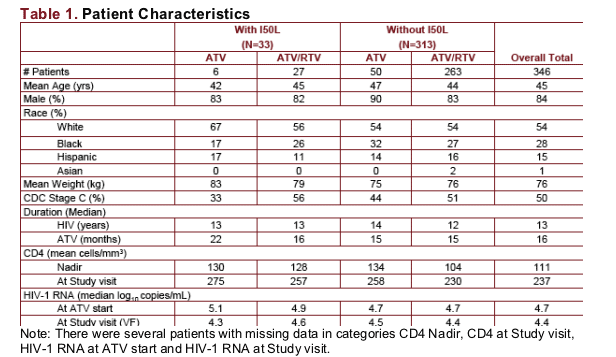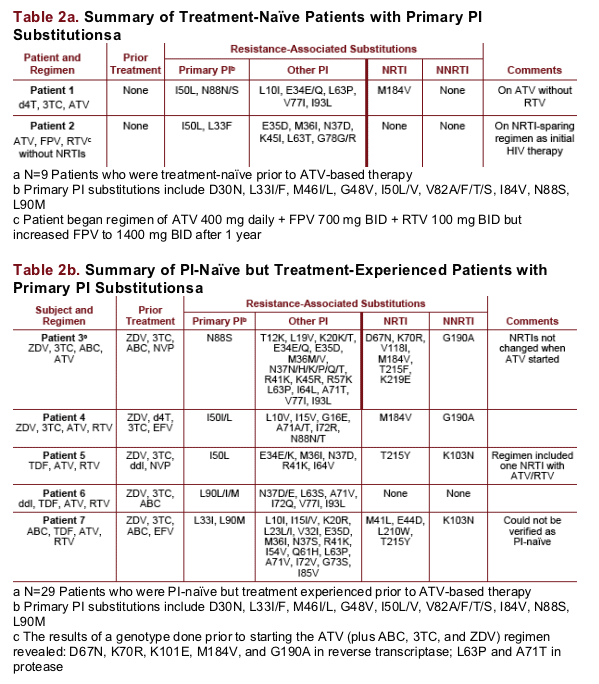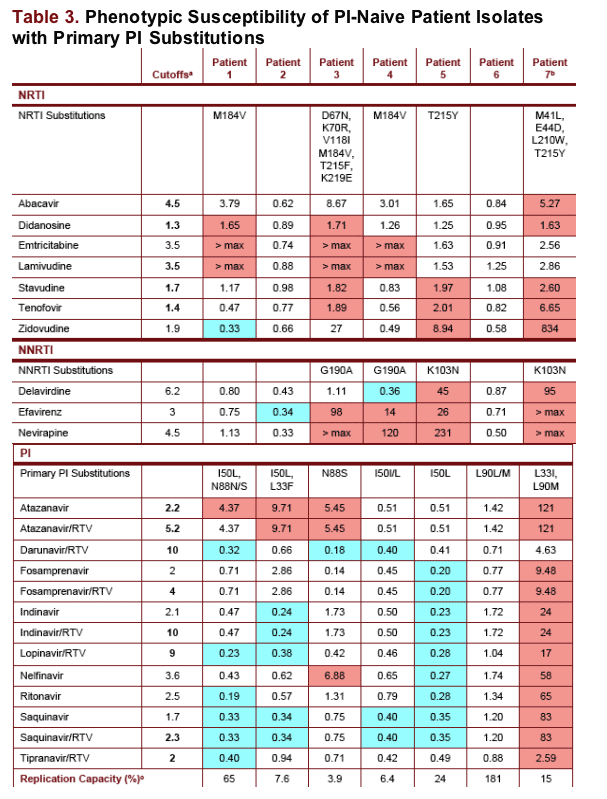 |
 |
 |
| |
Resistance Profile after Viral Rebound on Atazanavir-Containing Therapy:
Focus on Protease Inhibitor Naive Subjects in the IMPACT Study (BMS AI424-128)
|
| |
| |
Reported by Jules Levin
16th Intl HIV Drug Resistance Workshop, Barbados, June 12-16, 2007
A. Zolopa1, W. Towner2, D. Butcher3, S. Wang3, J.F. Maa3 and D. Seekins3
1Stanford University, Stanford Positive Care Clinic, Palo Alto, California, United States; 2Kaiser Permanente, Department of Internal Medicine, Los Angeles, California, United States; and 3Bristol-Myers Squibb, Virology Medical Affairs, Plainsboro, New Jersey, United States
AUTHOR DISCUSSION
The IMPACT Study is a cohort study that includes a wide clinical spectrum of patients and regimens that include ATV or ATV/RTV
Few studies of this sort and magnitude including both treatment history and resistance data have been undertaken with any PI
Consistent with earlier In vitro studies and clinical trials, the patients in this cohort who developed the I50L substitution showed a lack of cross-resistance to other PIs
Recent clinical studies have shown only isolated cases of emergence of PI resistance substitutions in treatment-naive patients failing on a boosted PI regimen4,5
No treatment-naive patient on ATV/RTV plus 2 NRTIs developed primary PI substitutions. Patient 2, on initial therapy with ATV/RTV, was found to have primary PI resistance substitutions I50L and L33F, but was noteworthy for being on a first-line dual-boosted PI regimen including ATV, FPV, and no nucleoside reverse transcriptase inhibitors. Recent results from ACTG 5142 and the OK4 Study revealed that NRTI-sparing regimens may increase the risk of primary PI substitutions6,7
The N88S substitution was selected by ATV in early in vitro studies.1 In the current study, two patients were found to have N88S, one as a lone primary PI substitution in a NRTI/NNRTI experienced patient and one in combination with
I50L in a treatment-naive patient. Both patients were on ATV without RTV boosting. A case report at CROI 2005 also identified a patient on ATV-based therapy with N88S who was treatment-experienced and significantly, had an
initial 5 months of exposure to ATV without RTV boosting before being switched to ATV/RTV8
One limitation of this study is the lack of baseline resistance data for all but one patient prior to starting ATV-based therapy. This would be of particular interest in the patient with L33I, L90M, and multiple secondary PI substitutions who could not be verified as PI-naive. Possible explanations for the degree of cross resistance seen in this patient would be transmitted (baseline) resistance or prior PI therapy. Other limitations include gaps in treatment history and small numbers of PI-naive subjects enrolled
AUTHOR CONCLUSIONS
In this second interim analysis of a cohort of patients with virologic failure on an ATV-containing regimen, the overall I50L prevalence was 33/346 (9.5%)
In PI-naive patients with primary PI substitutions, including I50L, susceptibility was maintained or increased to most PIs
No treatment-naive patient on ATV/RTV plus 2 NRTIs developed primary PI substitutions, including I50L
The N88S substitution was observed in two patients on ATV but was not seen in any patient on ATV/RTV
BACKGROUND
The resistance profiles of protease inhibitors (PIs) have mostly been ascertained from in vitro studies and clinical trials performed under carefully monitored conditions with standard regimens. In this setting, virologic rebound is detected early and resistance testing is performed. Few studies including a broad clinical spectrum of patients and regimens have been undertaken to evaluate the resistance profile of specific PIs
During early clinical studies of atazanavir (ATV), a unique resistance profile was elucidated: treatment-naive patients treated with ATV who developed virologic failure with protease inhibitor (PI) resistance did so only in the presence of the I50L substitution in the protease gene of HIV. This mutation distinguishes the resistance profile of ATV from the resistance profiles of all other currently marketed PIs. A study of clinical isolates has shown that, rather than creating resistance across the PI class, the emergence of I50L actually increases or maintains the susceptibility of HIV to other PIs.1 Hence, failure of an initial ATV-based regimen may preserve future treatment options
Currently, there are limited clinical data describing the emergent viral resistance patterns in patients who fail early lines of therapy with a HAART regimen that contains ATV and low-dose ritonavir (RTV).2 In a recently presented study of ATV/RTV compared to ATV, both with NRTIs (AI424-089), no patient on initial PI-based therapy with ATV/RTV was found to have primary PI resistance substitutions through 48 weeks3
In September 2004, the IMPACT Study was initiated to evaluate the resistance pattern of patients who experienced virologic failure while on an ATV-containing HAART regimen. Results from the second planned interim analysis are presented here with focus on patients who were reported to be PI-naive before starting ATV-based therapy.
OBJECTIVES
Primary Objective
To compare the prevalence of the I50L substitution in viral isolates from patients virologically failing ATV-containing HAART regimens with the prevalence of the I50L substitution in patients failing ATV/RTV-containing HAART regimens, regardless of prior treatment history.
Key Secondary Objectives
To compare the prevalence of the I50L substitution (regardless of RTV combination) in patients failing ATV as a first PI-containing regimen versus patients failing ATV as a second or later PI-containing regimen.
To describe patterns of amino acid substitutions in patients failing on ATV compared with ATV/RTV.
METHODS
Multicenter, cross-sectional study (USA & Europe) of HIV-infected treatment-experienced patients who have experienced virologic failure while on an ATV-containing HAART regimen
Enrollment planned at multiple sites over 5 years
Yearly analyses and reporting of the prevalence of I50L and other substitutions are done per study protocol due to the potential impact on clinical practice
Virologic failure (VF) is defined as either:
-- (1) a confirmed virologic rebound, defined as an HIV RNA by PCR ≥1000 copies/mL after achieving a value <400 copies/mL on at least two consecutive measurements ("Rebounder") or
-- (2) an HIV RNA ≥1000 copies/mL after 24 weeks of ATV therapy ("Non-Responder"), who were further classified based on VL response to current ATV-containing therapy
-- in both cases, HIV RNA ≥1000 copies/mL must be confirmed by screening measurement performed within 14 to 90 days of the first qualifying HIV RNA value of ≥1000 copies/Ml
Subjects enrolled between September 2004 and August 2006 for the current analysis
RESULTS
For this analysis, 346 patients enrolled
-- 38 of 346 patients were reported as PI-naive before initiation of ATV-based therapy; 9 treatment-naive, 5 NRTI-experienced, and 24 NRTI/NNRTI-experienced
-- For patients who were reported as PI-naive, attempts were made to verify treatment history to assure they did not have PI exposure before initiating ATV. For one of these patients, such confirmation could not be obtained

Majority with advanced AIDS:
--36% CD4 <200 cells/mm3
--50% CDC Stage C
--66% had HIV for 10+ years
Of 346 patients enrolled, 9.5% had I50L
Prevalence of I50L:
-- 9.3% (27/290) on ATV/RTV
-- 10.7% (6/56) on ATV

Of 38 patients with primary PI substitutions who were PI-naive before initiating ATV or ATV/RTV therapy, 7 were observed to have primary PI substitutions
--2 were treatment-naive, 1 was NRTI-experienced, and 4 were NRTI/NNRTI-experienced
--2 were on ATV (1 treatment-naive, 1 NRTI/NNRTI-experienced) and 5 were on ATV/RTV
The most common primary PI substitution observed was I50L (4 of 7 patients)
The N88S was seen in 2 patients on ATV (one with prior NRTI/NNRTI experience), but none on ATV/RTV
No treatment-naive patient on a ATV/RTV plus 2 NRTIs developed primary PI substitutions
Patient 2 was the only treatment-naive patient on ATV/RTV observed to have primary PI substitutions (I50L and L33F), but was on an uncommonly used NRTI-sparing dual-boosted PI regimen of ATV, FPV, and RTV
The combination of L33I and L90M occurred with multiple secondary substitutions in Patient 7, who could not be verified as PI-naive
Baseline resistance testing before ATV-based therapy was available for 1 subject with a primary PI resistance substitution, which showed significant NRTI and NNRTI resistance (see footnote)
NRTI substitutions were seen in 5/7 patients; most common were M184V alone in 2 patients, T215Y/F in 2 patients, and both M184V and T215F in 1 patient
NNRTI substitutions were observed in just over half of patients; 2 patients with K103N and 2 with G190A

Of PI-naive patients with primary resistance substitutions, most had reduced susceptibility to ATV
--Three patients had maintained susceptibility to ATV, one with I50L, one with I50I/L mixture, and one with L90L/I/M mixture
--Patient 1 (I50L + N88N/S) had reduced susceptibility to ATV but maintained susceptibility to ATV/RTV (fold change 4.37)
Most subjects with I50L and/or N88S had maintained or increased susceptibility to PIs other than ATV and ATV/RTV
--Patient 3 (N88S) had decreased susceptibility to NFV (fold change 6.88) while Patient 1 (I50L + N88N/S) had retained susceptibility to NFV (fold change 0.43)
Patient 7 (L33I and L90M) had extensive resistance to most antiretrovirals including all PIs except DRV, but could not be verified as PI-naive
Replication capacity in general was diminished
--One subject with L90M had replication capacity of 181%
REFERENCES
1. Colonno R, Rose R, McLaren C, Thiry A, et al. Identification of I50L as the Signature Atazanavir (ATV)-Resistance Mutation in Treatment-Naive HIV-1-Infected Patients Receiving ATV-Containing Regimens. JID. 2004;189:1802-1810.
2. Salama C, Caplivski D. Development of Atazanavir Resistance Mutations in a Clinical Setting among Patients without Evidence of Pre-existing Protease Mutations. Antiviral Therapy. 2005;10:S30.
3. Malan N, Krantz E, David N, Kastango K, et al. Efficacy and Safety of Atazanavir With and Without Ritonavir in Antiretroviral-Naive Subjects. Thirteenth Conference on Retroviruses and Opportunistic Infections; February 5-8, 2006; Denver, CO
4. Sax P, Xu F, Tisdale M, Elston R. First Report of Development of Resistance to Boosted Fosamprenavir in an ART-naive
Subject: Virologic and Clinical Outcome. The 45th Interscience Conference on Antimicrobial Agents and Chemotherapy (ICAAC). December 16-19, 2005; Washington, DC.
5. Friend J, Parkin N, Liegler T, Martin J, Deeks S. Isolated Lopinavir Resistance after Virological Rebound of a Ritonavir/lopinavir-based Regimen. AIDS. 2005; 18(14): 1965-1966.
6. Riddler S, Haubrich R, DiRienzo G, Peeples L, et al. A Prospective, Randomized Phase III Trial of NRTI-, PI-, and NNRTI-sparing Regimens for Initial Treatment of HIV-1: ACTG 5142. XVI International AIDS Conference. August 13-18, 2006; Toronto, Canada.
7. Arribas J, Pulido F, Delgado R, Cabrero E, et al. Drug Resistance Outcomes at 48 Weeks in the OK04 Trial: A Comparative Trial of Single-drug Maintenance Therapy With Lopinavir/Ritonavir vs Triple Therapy With Lopinavir/Ritonavir. 14th Conference on Retroviruses and Opportunistic Infections. February 25-28, 2007; Los Angeles, CA.
8. Coakley E, Mass M, Chappey C, Parkin N. Atazanavir (ATV) resistance in a protease inhibitor naive patient treated with ATV/ritonavir associated with development of high-level ATV resistance and N88S mutation in protease. 12th Conference on Retroviruses and Opportunistic Infections. February 22-25, 2005; Boston, MA.
|
| |
|
 |
 |
|
|